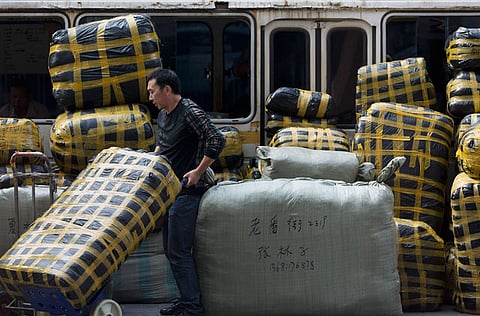China’s September export growth in surprise slide
Exports to Southeast Asia skid to 17-month low

Beijing: China’s export growth fizzled in September to post a surprise fall as sales to Southeast Asia tumbled, data showed, a disappointing break to a recent run of indicators that had signalled its economy gaining strength.
China’s exports dropped 0.3 per cent in September from a year earlier, the Customs Administration said on Saturday, sharply confounding market expectations for a rise of 6 per cent, and marking the worst performance in three months.
Imports fared better, rising 7.4 per cent in September from a year ago, better than forecasts for a 7 per cent increase, shrinking China’s monthly trade surplus to $15.2 billion (Dh55.8 billion).
Analysts said weak exports underscored worries about flagging global demand, which may crumble further in coming months — especially in emerging markets — when tighter US monetary policy pushes investors away from developing economies.
Indeed, the data showed Chinese exports to Southeast Asia, China’s fastest-growing export market in the past year, dived to a 17-month low in September. Capital outflows from the region on bets that the US central bank will cut its bond purchases had hit demand, said Louis Kuijs, an economist at RBS in Hong Kong.
“Looking ahead, export data may be quite weak in the coming months,” Kuijs said, adding that financial turmoil in several emerging markets had dragged on global demand.
Services sector
The dismal exports performance comes after the world’s No 2 economy showed encouraging signs of stabilisation, having fought a slowdown that lasted in 12 of 14 quarters. Trade, factory production and the services sector all picked up in the past two months.
Attention now turns to China’s third-quarter gross domestic product data and other figures for September due this week.
The median forecast of 21 economists in a Reuters poll showed economic growth is expected to quicken to 7.8 per cent in the third quarter from a year ago, up from 7.5 per cent in the previous three months.
“Developed economies have shown signs of recovery but they are still unstable. The global economic situation is still complicated,” Zheng Yuesheng, a spokesman for the customs office, told a media briefing on Saturday.
Albeit patchy, the rebound in the global economy helped lift China’s total trade growth to 6 per cent in the third quarter, from 4.3 per cent the previous three months, Zheng said.
Strong yuan, seasonal factor
A breakdown of the data showed exports to Europe, the second-biggest buyer of Chinese good after the US, South Korea, Taiwan, and Australia all fell last month.
Shipments to Taiwan struck a 17-month low while those to Australia posted their worst growth in three months.
Japan was the lone bright spot, registering growth for Chinese exporters for the first time in eight months. Sales to the United States cooled, even though the monthly value of exports were at their highest in over a year.
Liu Li-Gang and Zhou Hao, economists at ANZ Bank, said China’s sliding export sales were also a result of a rising yuan.
They said activity was further hurt by the Mid-Autumn festival, which fell in the middle of September this year, reducing the number of working days in the month compared with 2012.
“The strong yuan has eroded China’s export competitiveness,” ANZ Bank said in a note. It said there were risks that China’s economic growth may miss market forecasts this year, but predicted 2013 growth would hit 7.6 per cent.
The yuan, which hit a record high of 6.1090 to the dollar on August 12, has gained 5.7 per cent against 60 other currencies since January, data from the Bank of International Settlements showed, outstripping a 3 per cent rise in the dollar.
Confidence
In the face of China’s unsteady economic recovery, Beijing has repeatedly expressed confidence that the country can still achieve its 2013 growth target of 7.5 per cent.
Central Bank Deputy Governor Yi Gang was quoted as saying this week in Washington that China’s annual economic growth this year could hit about 7.6 per cent.
Anlaysts have long warned that a recovery in China’s economy may be fragile and brief, especially if Chinese leaders stick to plans for financial reforms, including curbing extravagant investment, which would hurt growth in the near term.
“Despite the subdued export outlook, we expect the government to maintain its current policy stance,” said Kuijs from RBS.
“We expect it to hold on to the firmer monetary stance that it is trying to pursue in order to rein in overall credit growth.”
Sign up for the Daily Briefing
Get the latest news and updates straight to your inbox


